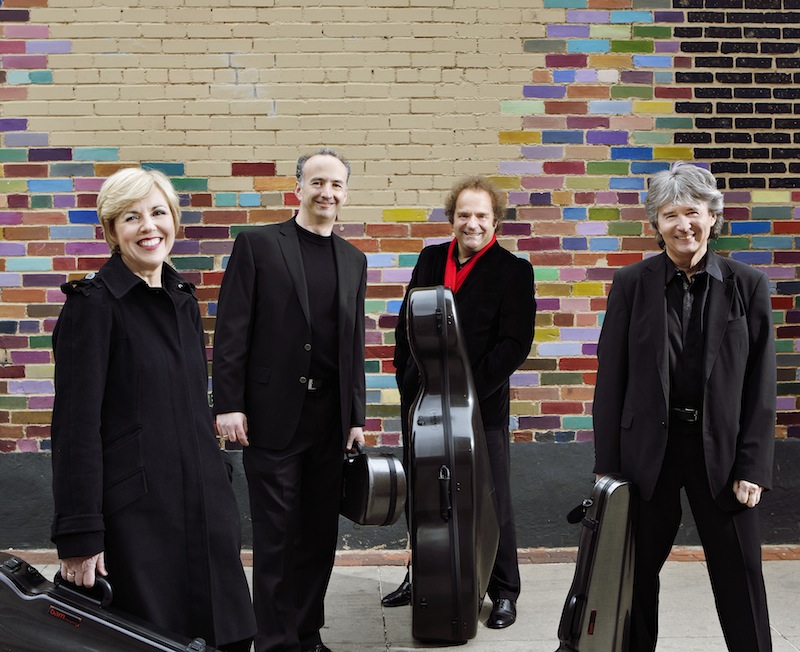Takács Quartet brings customary depth to Beethoven program

The Takács Quartet performed Wednesday night at the Kennedy Center. Photo: Keith Sanders
Chamber music, as the name implies, relies in good part on the intimacy of a room. When visiting the Kennedy Center, the Takács Quartet would normally play in the Terrace Theater, a venue made for close listening but that is undergoing renovation all this season.
For their performance Wednesday night, part of the Fortas Chamber Music Concerts series, the group played instead in the much larger Eisenhower Theater. The acoustical results were often infelicitous, as they were when Washington Performing Arts presented the same group in the cavernous Music Center at Strathmore in 2010.
The Takács Quartet knows how to use a warm, inviting acoustic to make a listener lean in and savor tiny musical details. Even with an acoustic shell and ceiling panels in place, the dryness of the room offered no sonic cloak for the group to clothe its sound.
A program surveying three quartets of Beethoven, from the early, middle, and late periods, should have been much more exquisite than it was. This group’s recordings remain among the finest of the Beethoven quartet cycle. The quiet, collaborative nature of these musicians finds its best expression in slow movements and dances in these quartets. The bolder side of Beethoven’s music, the rage and fury, tends to be somewhat underplayed, a quality made more noticeable by the acoustic.
As expected the late work, the Quartet in E flat major, Op. 130, played to their strengths. The slow introduction to the first movement had just the right sensuous quality, a lush melding of four instrumental voices. A sure ensemble footing made the movement’s stops and starts ideally coordinated, giving a sense of free movement of thought as faster roulades flowed into and back out of the slow material. Even through that long movement, rhetorically complicated, the group never lost the thread of the narrative.
The middle movements of Op.130 are a compilation of eclectic miniatures, to which the Takács gave pleasing individuality–from the restless gallop of the Presto, the multilayered melodic vitality of the Andante con moto, the graceful lilt of the Alla danza tedesca. The Cavatina stood out for its simplicity and rich tone, always moving forward, growing organically.
Beethoven’s original conclusion to this quartet, the mammoth “Grosse Fuge,” sticks out like a sore thumb from these little cameos. Beethoven replaced it with the shorter, almost comic finale played Wednesday, the last piece of music to flow from his pen, in a broad and genial rendition. The Takács brought out the piece’s lightly comic tone, almost Rossini-esque, without descending into vulgarity.
The acoustic enhanced the brightness of the violins’ sound, not always to the benefit of first violinist Edward Dusinberre, whose playing turned scratchy at times. This was evident in the somewhat workaday first movement of the early Op. 18 Quartet in G major. Dusinberre excelled, on the other hand, in the ornamented aria of the second movement, with the other three instruments forming a lustrous, soft accompaniment. The dance movement again proved the highlight, a tripping, comic scherzo, with second violinist Karóly Schranz sawing drunkenly away on the off-kilter interjections at the end of the trio. The humor of the finale succeeded well because it was understated, especially those surprise modulations to unexpected keys as the theme returned.
Least pleasing was the middle-period Quartet in F minor (“Serioso”), which sounded brash and even ugly in the agitated first movement. Some blame for this belongs to the acoustic, which also emphasized the strident qualities of the outer parts of the third movement (“Allegro assai vivace ma serioso”). Subtlety was the highlight of the slow movement, for example in the stacked-up dissonant chords which the group never hammered, letting the notes vibrate and shimmer against one another. Rather than a big conclusion, the fourth movement’s melancholy introduction made a vivid contrast to what followed, a bubbly “Allegro agitato” that rollicked like an opera buffa finale.
The Fortas Chamber Music Concerts continue with the Berlin-based ATOS Trio in a selection of music by Czech composers, 7:30 p.m. November 21. kennedy-center.org/calendar/event/MRFSD; 202-467-4600.
